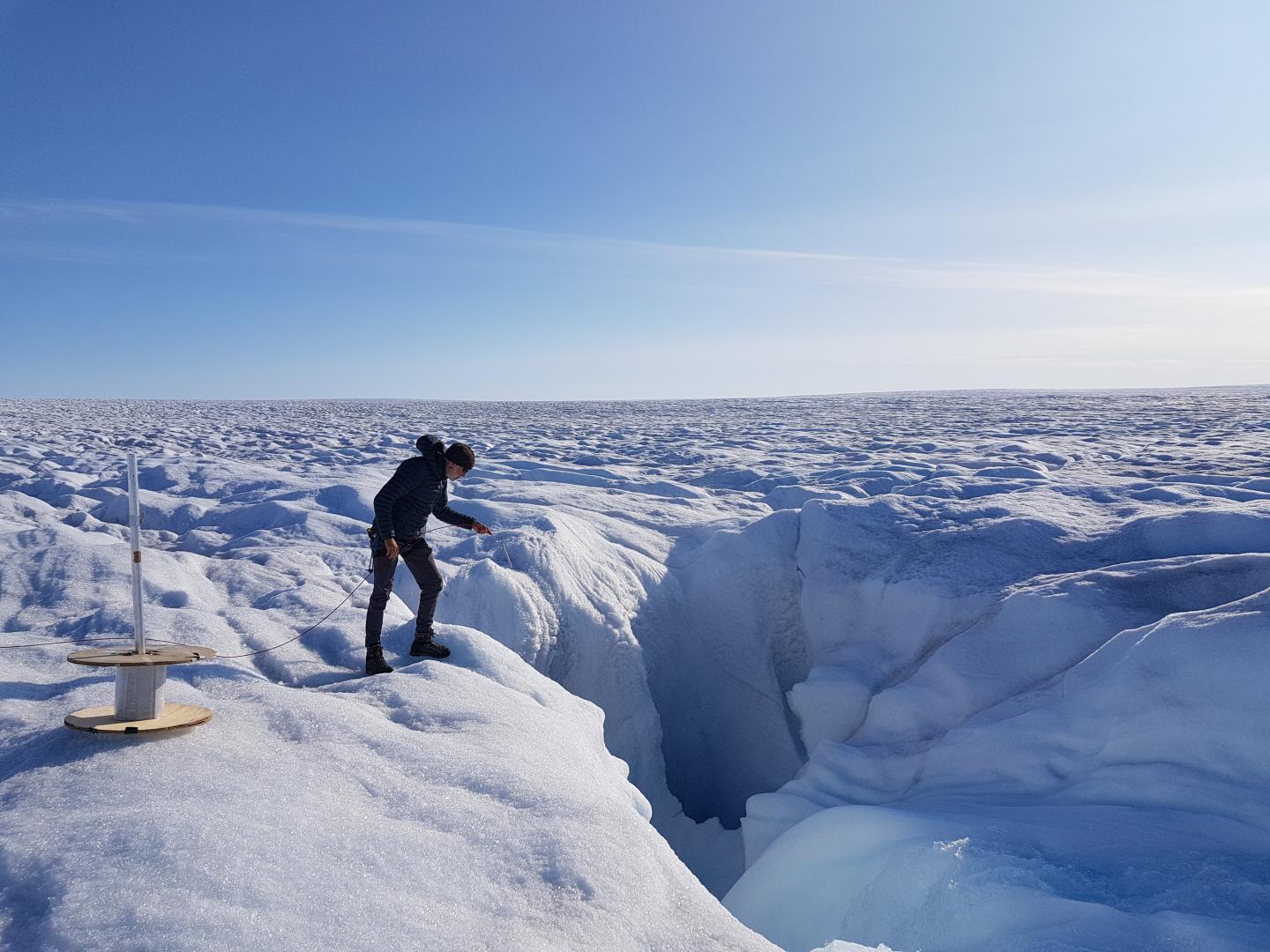The Greenland ice sheet looks tranquil. But inside it rumbles and grumbles as researchers, amongst whom two TU Delft scientists, found when drilling a kilometre deep hole.
The Greenland ice sheet is by no means a static massive lump of ice. It consists of layers with different properties, kind of like a layer cake made of stacked sheets of ice. Some layers are cold and dense, others are spongy and warmer due to thermodynamic processes at work like sheering and grinding. Determining what is happening in the kilometre thick ice sheet could give us more certainty of global sea-level rise.
These are, freely translated, some of the conclusions in a study led by the University of Cambridge which was published in the journal Science Advances earlier this month. Two of the co-authors are Bart Schilperoort and Bas des Tombe, of the Civil Engineering and Geosciences Faculty.
The research team used a technique called Fibre-Optic Distributed Temperature Sensing in which laser pulses are transmitted through a fibre-optic cable. With this method the researchers were able to obtain detailed measurements of ice properties and temperatures from the surface of the ice sheet all the way to its base, more than 1,000 metres below.
Transmitting laser pulses
Schilperoort and Des Tombe are experts in fibre-optic sensing. They have worked with this technique for years to study things like flows of groundwater and temperature gradients in forests. The idea is simple. You transmit laser pulses through the cable which you have hung on high poles in a forest for instance, or buried in the ground (for the groundwater measurements), and then record the distortions in the scattering of light in the cable, which vary depending on the temperature.
But the actual analysis of the data can be complicated, needing a lot of calibration and fine tuning. Being experts, Schilperoort and Des Tombe, were asked to join the British research team. “It was a great opportunity to learn about the properties of the Greenland ice sheet,” says Schilperoort.
Mass loss from the Greenland ice sheet has increased sixfold since the 1980s
The temperature of ice sheets was thought to vary in a smooth gradient, with the warmest sections on the surface where the sun hits, and at the base where it is warmed by geothermal energy and friction as the ice sheet grinds across the subglacial landscape toward the ocean.
Dust in the ice from past volcanic eruptions
The new study found instead that the temperature distribution is far more heterogeneous, with areas of highly localised deformation warming the ice further. This deformation is concentrated at the boundaries between ice of different ages and types.
Although the exact cause of this deformation remains unknown, it may be due to dust in the ice from past volcanic eruptions or large fractures which penetrate several hundred metres below the surface of the ice.
Mass loss from the Greenland ice sheet has increased sixfold since the 1980s and is now the single largest contributor to global sea-level rise. Around half of this mass loss is from surface meltwater run-off, while the other half is driven by discharge of ice directly into the ocean by glaciers that reach the sea.
Most surprising was warm ice more than 70 metres thick at the glacier’s bottom
To determine how the ice is moving and the thermodynamic processes at work within a glacier, accurate ice temperature measurements are essential. Conditions on the surface can be detected by satellites or field observations relatively straightforwardly, but determining what is happening at the base of the kilometre thick ice sheet is far more challenging. The lack of observations is a major cause of uncertainty in projections of global sea-level rise.
Accurate predictions
“We normally take measurements inside the ice sheet by attaching sensors to a cable that we lower into a drilled borehole, but the observations we’ve made so far weren’t giving us a complete picture of what’s happening,” said co-author Dr Poul Christoffersen of the Scott Polar Research Institute in a press release. “The more precise data we are able to gather, the clearer we can make that picture, which in turn will help us make more accurate predictions for the future of the ice sheet.”
The researchers found three layers of ice in the glacier. The thickest layer consists of cold and stiff ice which formed over the last 10,000 years. Below that, they found older ice from the last ice age, which is softer and more deformable due to dust trapped in the ice. What surprised the researchers the most, was a layer of warm ice more than 70 metres thick at the bottom of the glacier. The researchers concluded that the glacier produces heat due to friction with the glacier bed.



Comments are closed.